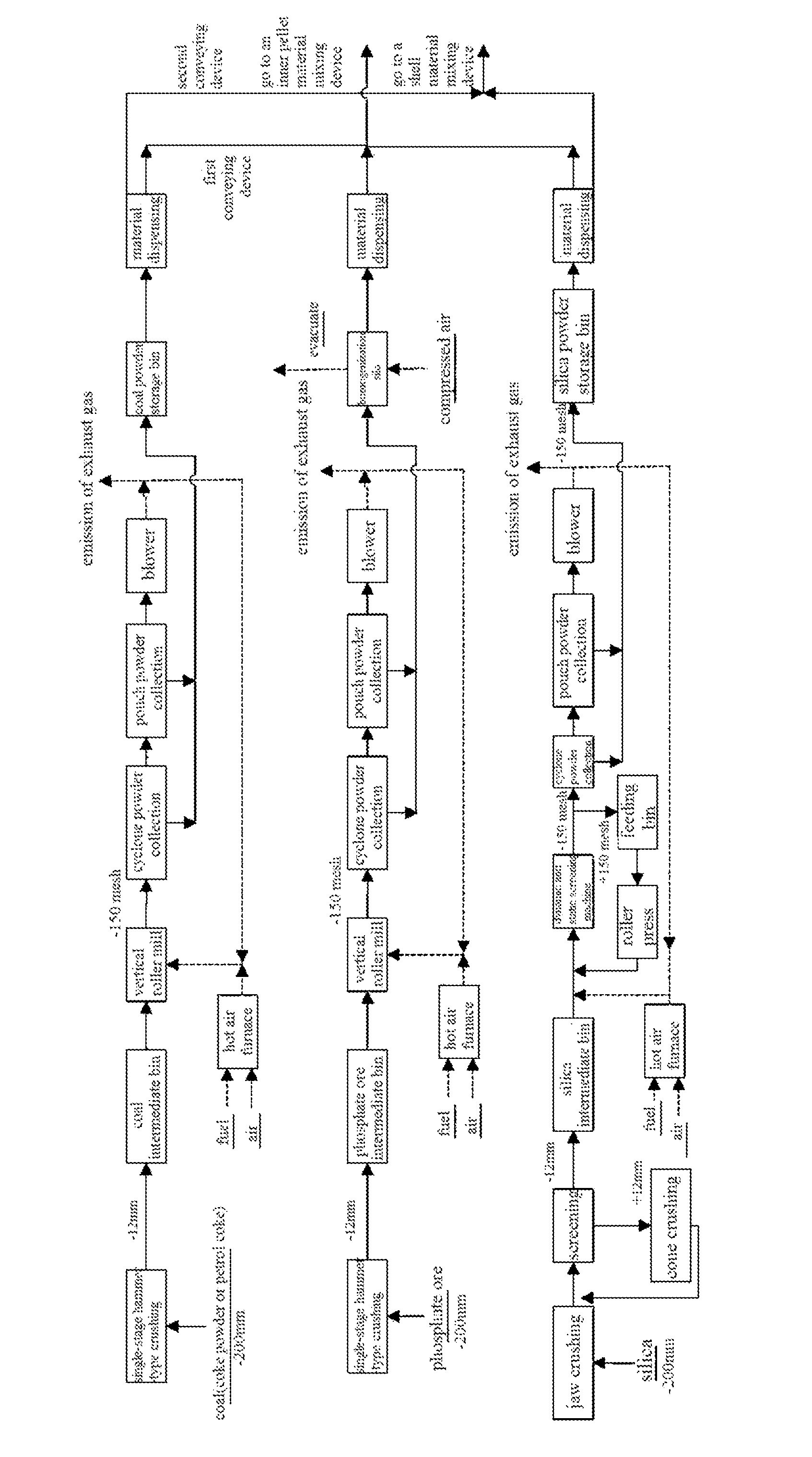This process has the following major drawbacks: the first drawback is large consumption of
sulfuric acid; the second drawback is that the
slag phosphogypsum cannot be used effectively, and
sulfuric acid, phosphoric acid and soluble fluorides entrained therein are all soluble in water, and rain wash of the
slag piled in the nature is apt to cause serious
pollution to the environment; the third drawback is that the
resultant phosphoric acid contains higher contain of impurities and is generally only used to produce
fertilizer; and the fourth drawback is that high-grade phosphate ore must be used to ensure economy of the product.
The hot-process production of phosphoric acid has the following main drawbacks: the first drawback is large consumption of electrical energy; the second drawback is that gas discharged out of the ore-
smelting electric furnace, from which P4 is already separated, still entrains a large amount of fluorides (existing in the form of SiF4 and HF) and a small amount of un-deposited gas P4, which causes serious
pollution to the atmospheric environment; the third drawback is that gas containing a large amount of CO is directly burnt and exhausted, which causes large waste of energy; the fourth drawback is that high-grade phosphate ore needs to be used to ensure economy of the production.
However, the research indicates that it is very difficult to implement the process of producing phosphoric acid with the kiln in large-scale industrial application and practice and its main drawbacks are as follows:1. A
rotary kiln is an apparatus with a kiln body rotating at a certain speed (0.5 r / min-3 r / min), and it is advantageous in continuously performing mechanical turn and mixture of a
solid material fed into the kiln to ensure uniformity of heat reception of the
solid material at all locations in the kiln.
However, the
solid material in the kiln must bear a mechanical frictional force resulting from movement of the material.
If a strength of the material is smaller than the received mechanical frictional force, the material can be easily destroyed.
If a conventional method of consolidating
pellets at a high temperature (≧900) at a chain grate in the
metallurgical industry is employed, the reducing carbon in the
pellets will be all oxidized, the
pellets entering the
rotary kiln will lose the reductant, carbon thermal reduction reaction of the
phosphorus naturally cannot be performed, and the process fails as a result.
Researchers desire gas volatized from the material layer to isolate the reduction zone from the oxidization zone in the
rotary kiln, but industrial experiments performed in a rotary kiln with an inner
diameter 2 m show that the phenomena of white crust rich in P2O5 on the surface of the pellets still cannot be avoided.
Due to the above-mentioned technical drawbacks, it is still very difficult to use the KPA process proposed by ORC Corporation in large-scale industrial application and practice to produce phosphoric acid.
However, increase of the
filling rate of the rotary kiln allows the material balls to bear larger mechanical frictional force in the rotary kiln, thereby causing a larger proportion of pulverization of the material balls in the rotary kiln, and forming more substances with a
melting point lower than the phosphate ore carbon thermal reduction temperature so that the high-temperature
ringing of the rotary kiln becomes quicker and more serious and earlier failure of the process is caused.
In addition, the volatile matter generated by added small amount of
petroleum coke is not sufficient to produce sufficient gas and it is difficult to form an effective
isolation layer between the
solid material layer of the rotary kiln and the gas flow area in the rotary kiln.
If an excessive amount is added, the materials in the rotary kiln will entrain a large amount of fuel so that in a slag ball cooling
machine in the subsequent process, the redundant fuel is confronted with the air for cooling the slag balls and burns rapidly, a large amount of heat resulting from the burning not only increases the difficulty in cooling the high-temperature slag balls exiting the rotary kiln but also substantially increases the production cost of the process and makes implementation of the commercialized and large-scale application of the process impossible.
However, in the course of the subsequent study, the inventors discovered a series of new technical problems, of which there are some technical problems reflected in raw material pre-treatment stage.
The raw material pre-treatment apparatus and the raw material pre-treatment process system employed in the raw material pre-treatment stage are not reasonable and scientific, and results in a relatively high process cost and
energy consumption; a more outstanding technical problem is that the proportions in raw materials with a large ratio fluctuation range, and mixed raw materials are not homogeneous enough, which result in a large fluctuation of a CaO / SiO2
molar rate in composite pellets, a further more serious problem of high-temperature ring formed by powder materials in rotary kiln and a further more
increased risk of failure of the process.
 Login to View More
Login to View More 
